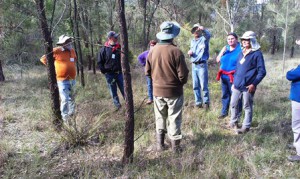Field Day June 2015
The HFFN field day on 21st June 2015 at Martindale provided an opportunity for members to look at Trevor’s proposal to thin an area of regrowth of Casuarina (Allocasuarina luemannii, bull oak). It is a long lived aggressive western species that comes into the Upper Hunter. The regrowth is probably the result of two previous fires and the large number of Casuarinas is changing a Vulnerable Ecological Community. The area previously had grasslands containing terrestrial orchids which are listed as a threatened species in the Muswellbrook LGA. We walked through the area before work on thinning began and saw the magnitude of the problem. The HFFN consensus on how to thin or remove the trees included noting that poisoning of the trees could destroy the mycorrhiza fungi which will impact on the regrowth of orchids. Cutting and pasting the trees at hip height, purely mechanical removal and mulching them with a forestry mulcher were all canvassed. Carrying out pilot studies on small areas with different approaches, including poisoning was recommended.
The property has a 15 year old plantation of Eucalypts that has been pruned and thinned. Species include Slaty Gum, Forrest Red Gum, River Red Gum, White Box, Grey Gum and Iron Bark.
A general meeting held after lunch reported on future field days and potential funding from LLS for proposed mentors. The previous field day suggested that a course ‘An Introduction to Farm Forestry’ be held. As a result of the mentoring program this will not happen this year. Details of the field days and mentoring program will be put on the HFFN web site and emailed to members when the dates and details are confirmed.
Some members and Trevor discussing the issues amongst the Casuarinas
